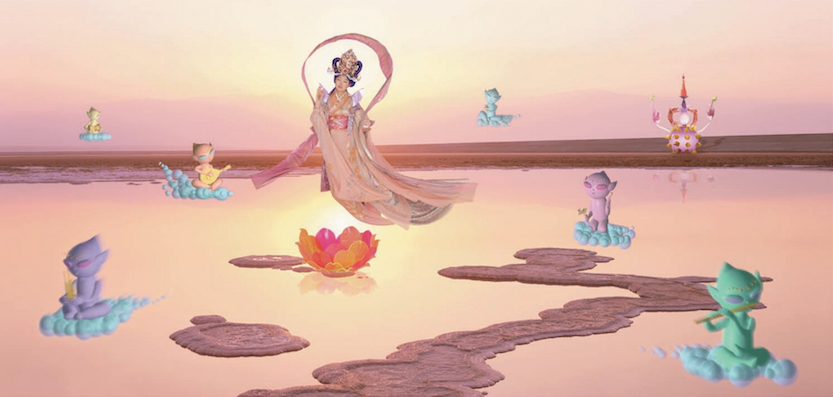Floating on a lotus blossom
Immersion
Artist as object
Another element typical in Mori’s work is for the artist to cast herself in the principle role, and Pure Land is no exception. The central female figure is the artist herself, wearing an elaborate costume and headdress, both of her own design. Born in Tokyo in 1967, Mori studied design at Tokyo’s Bunka Fashion College and worked part-time as a fashion model, which she originally considered a form of personal creativity. However, she found modeling an inadequate medium in which to express herself fully, so she began to stage elaborate tableaux, taking full creative control of the process, acting as director, producer, set and costume designer, and model. This recalls the practices of other photographers, most notably Cindy Sherman, as well as Yasumasa Morimura, the Japanese photographer notorious for substituting himself for figures in famous paintings throughout art history.
In the Pure Land photograph, Mori’s light blue, pupil-less eyes, gaze serenely somewhere beyond our vision. Like the Amida Buddha, she rests above a lotus blossom and holds her right hand in a mudra of blessing and teaching; the circle formed by the index finger and thumb is the sign of the Wheel of Law. In her left hand she holds a hojyu, or magical wishing jewel, in the shape of a lotus bud. This figure is inspired by Kichijoten, originally the Indian goddess, Shri Lakshmi, who was eventually incorporated into Buddhism, and typically represents fertility, fortune, and beauty. Here Mori bares comparison with a well-known eighth-century painting of Kichijoten from Yukushi-ji Temple in Nara. Similarities include the serene elegance, softly fluttering gown, and wish-granting jewel. The eighth-century painting depicts the clothing and appearance of an elegant lady of the Chinese Tang Dynasty, and it may have been an object of veneration during the annual New Year event when devotees prayed for happiness and fertility. In this manner, a beautiful, elegant woman was seen to embody the ideas of good fortune and prosperity and became an object of worship.








